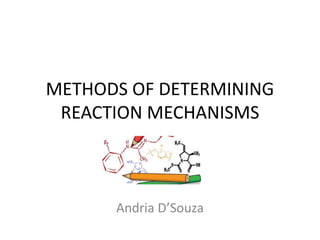
Methods of Determining Reaction Mechanisms - Andria D'Souza
- 1. METHODS OF DETERMINING REACTION MECHANISMS Andria D’Souza
- 2. What is a mechanism of a reaction?
- 3. What is a mechanism of a reaction? • Step by step description of the reaction • Information about a. position b. shifting and movement
- 4. • Detailed reaction mechanism cannot be elucidated • Only PROPOSED mechanism that is put forward i. energetically reasonable ii. account for the experimental observations iii. in agreement with what is known about analogous reactions
- 6. Methods adopted for determining the mechanism of a reaction: • Isotopic labelling technique • Stereo chemical evidences • Cross over experiments • Identification of product • Identification of reaction intermediate
- 7. ISOTOPIC LABELLING TECHNIQUE • In this method a single atom of any chemical compound is replaced by its isotopes. • 3H Tritium, 2H Deuterium, 13C, 14C, 15N and 18O are the most common isotopes which are frequently used.
- 10. STEREOCHEMICAL EVIDENCES • stereochemistry of the reactant and the product. • optically active substrate optically inactive product RACEMIC MIXTURE SN 1 mechanism • optically active substrate optically inactive product an inverted configuration : WALDEN INVERSIONSN 2 mechanism.
- 13. CROSSOVER EXPERIMENTS • To study mechanism of molecular rearrangement reactions • INTRAMOLECULAR rearrangement or INTERMOLECULAR rearrangement • two non identical reactants differ by one characteristic group
- 16. IDENTIFICATION OF REACTION INTERMEDIATES • Reaction intermediates are an important class of chemical species, which are quite helpful in understanding the mechanism of a chemical reaction. 1. Isolation 2. Detection 3. Trapping
- 17. ISOLATION: • These species by nature are unstable under normal reaction conditions, but they can be isolated under favourable conditions either in pure state or in their form of solution. • The Hoffmann rearrangement amide amine formation of isocyanate intermediate isolation of isocyanate intermediate
- 19. DETECTION: • Stable intermediates long lifetime high concentration detected by spectroscopic methods. • FUN FACT: George Olah of California University got the noble prize in 1994 for his work on cation. He was able to prepare a number of stable, long lived carbocations and recorder their 13C NMR spectra.
- 20. TRAPPING: • Intermediates that are not capable of being isolated, as they are not quite stable or are quite low in concentration, are characterised by trapping them with a suitable reagent. • These reagents form products with the intermediate which are particularly characteristic of the species.
- 21. • Base promoted solvolysis of chloroform when carried out in the presence of cyclohexene, the dichlorocarebene is trapped and an adduct, cyclopropane derivative is obtained
- 23. IDENTIFICATION OF PRODUCTS • basic framework: reactants, intermediates, products • elucidation of the reaction mechanism • identifying intermediates very short lifetime low concentration • UV, IR, ESR, 1H NMR, 13C NMR and Mass
- 24. • The reaction of o-chlorotoulene with a strong base not only gave the expected m-cresol but also, the unexpected o-cresol. The formation of both the products can only be explained by the formation of benzyne intermediate.
- 25. REFERENCES: • Advanced Organic Chemistry by Dr. Jagdamba and Dr. Yadav • Conceptual Organic Chemistry by Arun Seti
